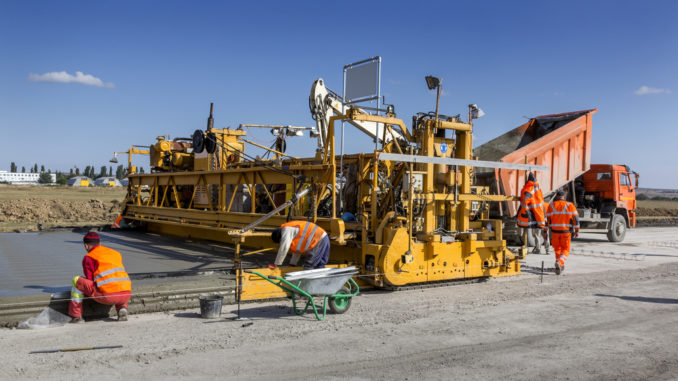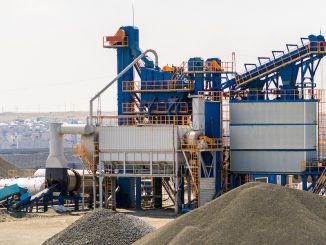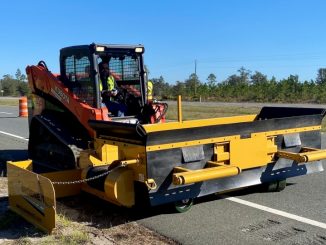
View the complete article here.
When designing concrete pavement, the goal is to find the right balance of cost, efficiency, and performance. The objective is to choose the features that will fit the needs of the project while managing the costs of installation and the various conditions that might impact the durability of the materials.
For many years, concrete pavement design was focused only on the thickness of the slab. Now, contractors can use an integrative approach to optimize performance. Features including joint dimensions, load transfer requirements, and reinforcement can also be evaluated to meet the needs of each job site.
Types of Concrete Pavement
Three common pavement designs are used for pavement construction:
- Jointed Plain Concrete Pavements (JPCP): The logical design for concrete pavement since it is a reliable method and a cost-effective way to complete the job. The majority of concrete pavements are designed to be jointed without reinforcements.
- Jointed Reinforced Concrete Pavements (JRCP): This format uses both joints and reinforcements, usually in the forms of deformed steel bars or welded wire fabric. The design is useful to hold the slab together, even if transverse cracks form. This method was often previously used for state highways, but it isn’t as common now.
- Continuously Reinforced Concrete Pavements (CRCP): In this design, there are no transverse joints. Longitudinal and transverse reinforcements are used, which helps to hold cracks together if they form. There are times when reinforced, unjointed pavement designs can offer better performance. Even though this modern method comes at a higher cost, the expense is warranted in high traffic, urban areas.
What Are Your Goals for the Project?
As you are designing the concrete pavement, it is essential first to identify the parameters that need to be met:
- Structural Performance: Ensuring that the concrete can handle the anticipated traffic loads and volumes. Additionally, it is important to consider how environmental factors might influence the structural performance. Design features to improve structural performance include support, stiffness, strength, reinforcement, and slab thickness. Improper design for structural performance could result in cracking due to the heavy loads, appearing as longitudinal cracks, transverse cracks, or corner cracks.
- Functional Performance: The features that affect the comfort of the ride. When designing the concrete pavement for functionality, it is important to consider the environment, concrete materials, and construction practice. How does the surface friction impact the quality and comfort of passengers in the cars? Not only does the friction affect the smoothness of the drive, but the wrong driving surface can also affect geometrics and noise. Even though surface friction isn’t technically considered a design element, the friction has an impact on skid resistance and noise levels. It is important to find a balance between noise and friction: too much friction will increase noise levels, but not enough friction will have a negative impact on skid resistance. Texturing techniques are typically created by dragging materials, such as a tining device, over the fresh concrete to create the necessary texture.
- Length of Use: What is the target service life for the concrete? Pavement can be designed to last anywhere from 10 years to more than 60 years if needed. Factors that influence the length of use include the thickness of the slab and the quality of materials that are used for construction. The highest performance concrete mixtures often include well-graded coarse aggregate, protection against freeze-thaw patterns with targeted air content, granulated blast-furnace slag for reduced permeability, and the right ratio of water and cement materials. Additionally, it is essential to use the right curing techniques. If the concrete needs to have a long service life, then it is usually best to choose experienced contractors who understand the importance of considerable care for the installation and techniques.
- Concrete Strength: All pavement design procedures usually use primary thickness as a measurement for concrete strength. The flexural strength is a characterization of the strength that is needed based on the anticipated loading that the pavement will endure.
- Thermal Expansion and Contraction: All areas are affected by temperature and weather changes, but certain climates have a higher risk of expansion and contraction. Factors that affect the expansion and contraction include the joint spacing, curing method, aggregate quantities and types, the ratio of water and cement materials, as well as the total water content in the mix. When volume changes happen in the concrete, then there is a risk of warping and slab curling which has an impact on the long-term performance of the pavement.
- Concrete Durability: Will the concrete be durable in the environmental conditions? The goal is to minimize deterioration due to the freeze-thaw cycles that happen throughout the year. Other factors that can affect durability include internal reactions between the aggregates and portland cement as well as chemical reactions with the concrete materials and the environment. It has been said that the durability of the concrete will have the greatest impact on the lifespan of the pavement. To govern durability, it is necessary to assess the construction specifications as well as using the right quality of materials.
If concrete strength is a high priority, then slab thickness is often the focus of the design. But, other concrete properties need to be considered as well. For example, using the right construction specifications and materials will affect the durability to ensure long-term performance.
Evaluating Site Variables
Not only will the above materials and design factors affect the concrete performance, but other support features need to be built into the design. It has been found that environmental factors can play a big role in the quality and lifespan of the concrete, but these factors are often overlooked in the design process.
Precipitation will play a role in the performance of the concrete, which is why the pavement needs a uniform subgrade/base support, with features that incorporate a draining system. Temperature can also impact the expansion and contraction of the materials. When the pavement is laid in an area with severe climate changes (such as snow or high levels of rainfall), then the cement might have a shorter lifespan compared to the same materials installed in an area with a moderate climate.
Additionally, traffic data needs to be measured to estimate the trucks that will use the pavement as well as the anticipated weight load of the vehicles. Effective design should be focused on the number of trucks and the axle loads (load footprint, axle spacing, axle type, axle weight, and more).
Finalizing the Concrete Pavement Design
The real-world application of these design principles needs to marry the mechanical principles that affect damage accumulation with the empirical data for calibration and validation. Using the right data inputs and values will ensure the validity of the pavement designs.
At the same time, the design partners need to work with a construction team that has extensive knowledge and experience with concrete. A collaborative approach with designers and the construction crew ensures that the project is cost-effective, buildable, and biddable. It is also important to consider the future maintenance that will be required to protect the lifespan of the pavement.
Early planning and collaboration help to reduce the risk of scope changes, delays, and construction costs. The design needs to include information about the availability of quality materials, as well as the availability of competent contractors to complete the work.
Rehabilitation with Overlays on Concrete Pavements
At times, concrete overlays can be used to rehabilitate asphalt pavements and existing concrete if damage has occurred. Concrete overlays are not effective for every situation though. For example, if the damage is due to distress because of the low quality of the materials that were used, then it usually isn’t worth the expense to complete an overlay. If the pavement is cracked, then it is likely that the cracks will be reflected on the new overlay unless a separation layer is created.
These are some of the common types of concrete overlays that might be used:
- Bonded Concrete Overlays: A monolithic structure is created by placing a thin surface layer of concrete on the existing pavement. This method can be effective to improve the ride quality or to increase the structural capacity.
- Unbonded Concrete Overlays: Also known as Separated Concrete Overlays. An interlayer of hot mix asphalt is placed between the new surface layer and the existing concrete. An inch of interlayer is helpful to ensure independent movement of each of the layers. As a result, it decreases the risk of reflective cracking.
Whitetopping is a method that can be used to place overlays on asphalt pavements. Conventional whitetopping is a technique where the concrete overlay is put on a pavement of distressed asphalt. The performance of the overlay can be improved by creating a bond with the concrete and a hot mix asphalt. Thin whitetopping can be used in a similar way if the roadway has a lower volume of traffic, without the thickness that is required for the conventional whitetopping techniques. A monolithic structure can be designed by milling the existing pavement to improve the bond between the concrete and asphalt pavement.
The most important factor that needs to be considered is the way the existing pavement will interface with the overlay. The curing of the overlays will affect the potential for curling and warping stresses. Adequate curing is essential to provide the resistance that is needed against both water penetration and abrasion.
View the complete article here.
What are the common types of concrete pavement designs, and how do they differ?
Three common designs are Jointed Plain Concrete Pavements (JPCP), Jointed Reinforced Concrete Pavements (JRCP), and Continuously Reinforced Concrete Pavements (CRCP), each serving specific construction needs and durability considerations.
What factors should be considered when designing concrete pavement for optimal performance?
Key considerations include structural and functional performance, length of use, concrete strength, thermal expansion/contraction, and durability, with factors such as weather, traffic, and support features influencing the design process.












































